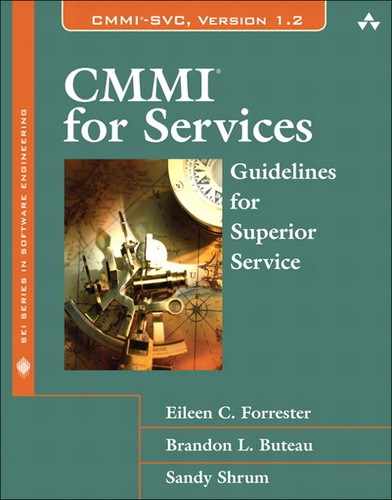Chapter 4. Achieving Process Improvement That Lasts
Overview
This chapter explains how CMMI models ensure lasting process improvement. Making improvements to achieve business objectives is only half the job. The other half is ensuring that these improvements persist.
Lasting Improvement
Lasting improvement requires establishing processes that are institutionalized, which means they are absorbed into the organization’s standard way of doing business. Institutionalized processes are more likely to persist during times of stress.
So, how do processes become institutionalized? Research has shown that to become institutionalized, processes must be supported by the organization. In CMMI models, this support is embodied in the generic goals and practices. When the organization implements these practices, it increases the permanence of its processes. That is why implementing only the specific practices of a process area is not enough; you must also implement the generic goals and practices.
The degrees of process institutionalization that CMMI models support are expressed in the types of processes the generic goals and practices enable.
As generic goals and practices are implemented for a process area, the practices of the process are more likely to last. Processes can be expressed as process types, which include incomplete, managed, defined, quantitatively managed, and optimizing processes.
These process types are described in the following subsections. Each succeeding process type reflects its increasing permanence in the organization.
Incomplete Process
An incomplete process is a process that either is not performed or is partially performed. One or more of the specific goals of the process area are not satisfied and none of the generic goals are satisfied.
Performed Process
A performed process is a process that accomplishes the work necessary to produce work products and enables the work needed to establish, deliver, and manage services. The specific goals and specific practices of the process area are implemented.
Managed Process
A managed process is a performed process that establishes discipline and control to ensure continued performance in times of stress.
The organization establishes the requirements and objectives for the process. The status of the work products and delivery of the services are visible to management at defined points (e.g., at major milestones and at the completion of major tasks). Commitments are established among those performing the work and the relevant stake-holders and are revised as necessary. Work products are reviewed with relevant stakeholders and are controlled. The work products and services satisfy their specified requirements.
A critical distinction between a performed process and a managed process is the extent to which the process is managed. A managed process is planned (the plan may be part of a more encompassing plan) and the execution of the process is managed against the plan. Corrective actions are taken when the actual results and performance deviate significantly from the plan. A managed process achieves the objectives of the plan and is institutionalized for consistent performance.
Defined Process
A defined process is a managed process that the organization tailors from its set of standard processes according to its tailoring guidelines; has a maintained process description; and contributes work products, measures, and other process improvement information to organizational process assets.
See the glossary for the definitions of organization’s set of standard processes, organizational process assets, and standard process.
The organization’s set of standard processes is the basis of a defined process. The infrastructure to support current and future use of the organization’s set of standard processes is established and improved over time.
There are two critical distinctions between a managed process and a defined process.
The first is the scope of standards, process descriptions, and procedures. A managed process can apply to only one project, whereas a defined process is tailored from the organization’s set of standard processes.
The second distinction is the rigor used to describe processes. A defined process is managed more proactively using an understanding of the interrelationships of the process activities and detailed measures of the process and its work products.
A defined process clearly states the following:
• Purpose
• Inputs
• Entry criteria
• Activities
• Roles
• Measures
• Verification steps
• Outputs
• Exit criteria
Quantitatively Managed Process
A quantitatively managed process is a defined process that is controlled using statistical and other quantitative techniques. Quality and process-performance attributes are measurable and controlled throughout the project.
Performance models are used to set performance objectives for service provider performance and to help achieve business objectives. Quantitative objectives for quality and process performance are established and used as criteria in managing the process. Quality and process performance are understood in statistical terms and are managed throughout the life of the process. Quantitative objectives are established based on the capability of the organization’s set of standard processes; the organization’s business objectives; and the needs of the customer, end users, organization, and process implementers, subject to the availability of resources. The people performing the process are directly involved in quantitatively managing the process.
The subprocesses that are significant contributors to overall process performance are statistically managed. For these subprocesses, special causes of process variation are identified and, where appropriate, the source of the special cause is addressed to prevent its recurrence.
For selected subprocesses, specific measures of process performance are collected and statistically analyzed. When selecting them for analyses, it is critical to understand the relationships between processes and subprocesses and their impact on performance. Such an approach helps to ensure that quantitative and statistical management is applied where it has the most overall value to the business.
Quality and process-performance measures are incorporated into the organization’s measurement repository to support future decision making.
Quantitatively managing the performance of a process includes the following activities:
• Identifying the subprocesses to be statistically managed
• Identifying and measuring work product and process attributes that are important to quality and process performance
• Identifying and addressing special causes of subprocess variations
• Managing the selected subprocesses, to bring their performance within natural bounds (i.e., making the subprocess performance statistically stable and predictable based on the selected work product and process attributes)
• Predicting the ability of the process to satisfy quantitative quality and process-performance objectives
• Taking appropriate corrective action when quality and process-performance objectives will not be satisfied
The difference between a quantitatively managed process and a defined process is the predictability of process performance. A quantitatively managed process controls its performance using statistical and other quantitative techniques and is quantitatively predictable. A defined process is typically only qualitatively predictable.
Optimizing Process
An optimizing process is a quantitatively managed process that has a continually improving range of process performance through both incremental and innovative improvements. An optimizing process continually improves process performance through incremental and innovative technological improvements.
Quantitative process improvement objectives are established, continually revised to reflect changing business objectives, and used as criteria in managing process improvement. Both the defined processes and the organization’s set of standard processes are two common targets of measurable improvement activities.
Selected incremental and innovative technological process improvements are systematically managed and deployed. The effects of the improvements are measured and evaluated against quantitative process improvement objectives.
In a process that is optimized, common causes of process variation are addressed by improving the process to shift the mean or decrease variation when the process is restabilized. (See the definition of common cause of process variation in the glossary.)
The difference between a quantitatively managed process and an optimizing process is that a quantitatively managed process addresses special causes of process variation and provides statistical predictability of results. An optimizing process continuously improves by addressing common causes of process variation. Although a quantitatively managed process may produce predictable results, the results may not be sufficient in an increasingly competitive business environment.
Understanding Generic Practices
Generic practices ensure a degree of permanence in a variety of ways that include but are not limited to the following:
• Creating policies and securing sponsorship
• Ensuring that the work unit and/or organization has the resources it needs
• Managing the performance of the process, managing the integrity of its work products, and involving relevant stakeholders
• Reviewing with higher level management and objectively evaluating conformance to process descriptions, procedures, and standards
The generic goals and practices are listed in the first section of Part Two, including notes and subpractices that further explain them.
Applied sequentially and in order, the generic goals describe characteristics of processes that are increasingly institutionalized from performed processes to optimizing processes.
Generic goals and their practices are designed to be applied to processes associated with each process area.
Achieving GG 1 for a process area is the same as achieving the specific goals of a selected process area.
Achieving GG 2 for a process area is managing the performance of processes associated with the process area. This management includes a policy that indicates you will perform the process, a plan for performing the process, resources, assigned responsibilities, training, controlled work products, and so on.
Achieving GG 3 for a process area assumes that an organizational standard process exists that can be tailored to result in the process you will use.
Achieving GG 4 or GG 5 for a process area is conceptually feasible but may not be economical except, perhaps, in situations where the domain has become stable for an extended period or in situations in which the process area or domain is a critical business driver.
The generic goals and generic practices are used as part of achieving capability and maturity level ratings. Table 4.1 illustrates the relationships between the generic goals and practices and the maturity and capability levels.
Table 4.1 Model Elements Affecting Process Institutionalization

Understanding Capability Levels
The capability level of a process area indicates how lasting the associated processes are likely to be. A process area is given a capability level rating based on the highest generic goal satisfied.
Implementing only the specific practices of a process area will achieve capability level 1, which means that the process is performed, but it may not last.
As the organization implements the generic practices for a process, it increases the chances that the process will become part of the way the organization does business. Capability levels measure this increase in permanence for each process area by generic goal (or group of generic practices) as described in Table 4.2.
Table 4.2 Capability Levels and Generic Goals
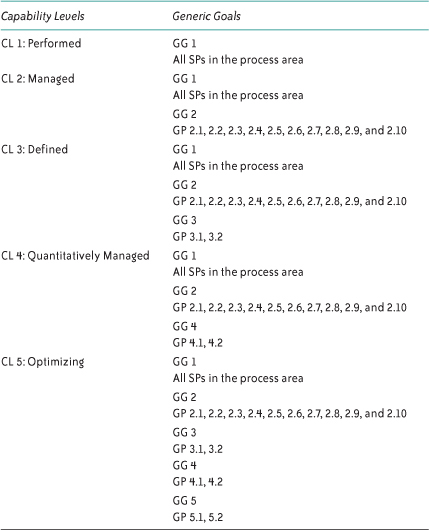
Implementation of all generic practices for every process area is not realistic. Each process area can benefit from the GPs at capability levels 2 and 3 to make the associated improvement more permanent. However, once you get to generic goals 4 and 5, the emphasis changes to quantitative control. These generic practices should focus only on subprocesses that are indicators for the critical aspects of your business. Therefore, these generic practices should be limited to a subset of process areas.
Measuring subprocesses, statistically managing them, and subsequently optimizing their selection and performance is a way to control a process to ensure that it continues to meet the needs of the organization and its customers. That is the purpose and function of generic goals 4 and 5.
However, most processes need generic goals 2 and 3 and the level of control and permanence that they ensure.
Understanding Maturity Levels
Maturity levels indicate how advanced an organization’s processes are as a whole. Each process area has a maturity level assigned to it; for example, “CM is a maturity level 2 process area.” To achieve a maturity level, all of the goals of the process areas belonging to that maturity level must be satisfied.
In other words, maturity level 2 (the lowest available maturity level) means that more than just the generic goals and practices are implemented; it also means that a whole set of process areas was implemented.
An organization achieves a maturity level rating based on the highest generic goal implemented and the highest maturity level process areas satisfied. (Maturity levels are less directly related to generic practices than capability levels, but they do relate.) Maturity levels are implemented in order from 2 through 5.
As the organization achieves increasing maturity levels, it reinforces the process that will become part of the way the organization does business. Maturity levels measure this increase in permanence as described in Table 4.3.
Table 4.3 Maturity Levels, Process Areas, and Generic Goals
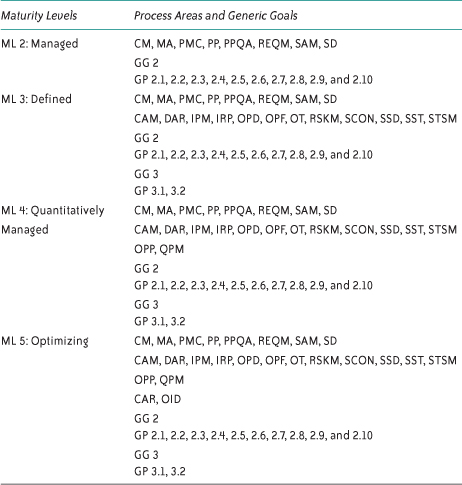
Implementation of all generic practices for every process area is not realistic. Once you reach maturity levels 4 and 5, the maturity levels no longer rely on the generic practices to increase control and permanence: These characteristics are achieved by the maturity level 4 and 5 process areas.
The maturity level 4 and 5 process areas should focus only on subprocesses that are indicators for the critical aspects of your business.
Measuring subprocesses, statistically managing them, and subsequently optimizing their selection and performance is a way to control a process to ensure that it continues. That is the purpose and function of the process areas staged at maturity levels 4 and 5.
Comparing Capability Levels and Maturity Levels
Capability levels support the continuous representation of the model. Maturity levels support the staged representation of the model.
Process areas are viewed differently in the two representations. Figure 4.1 compares how process areas are used in the continuous and staged representations.
Figure 4.1 Process Areas in Continuous and Staged Representations
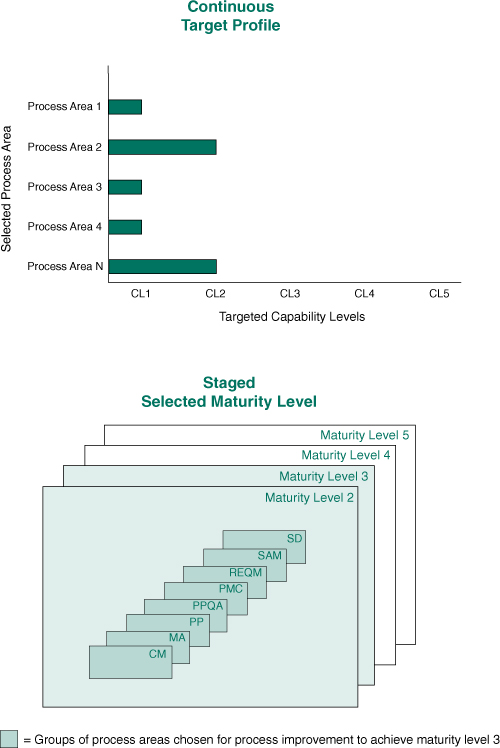
The continuous representation enables the organization to focus its process improvement efforts by choosing those process areas, or sets of interrelated process areas, that best benefit the organization and its business objectives. Although there are some limits on what an organization can choose because of the dependencies among process areas, the organization has considerable freedom in its selection.
To assist those using the continuous representation, process areas are organized into four categories: Process Management, Project Management, Service Establishment and Delivery, and Support. These categories emphasize some of the key relationships that exist among the process areas.
Once you select process areas, you must also select how much you would like to improve the processes associated with those process areas (i.e., select the appropriate capability level). Capability levels and generic goals and practices support the improvement of processes associated with individual process areas. For example, an organization may wish to reach capability level 2 in one process area and capability level 4 in another. As the organization achieves a capability level, it sets its sights on the next capability level for one of these same process areas or decides to widen its view and address additional process areas relevant to its business goals.
This selection of a combination of process areas and capability levels is typically described in a “target profile.” A target profile defines all of the process areas to be addressed and the targeted capability level for each. This profile governs which goals and practices the organization will address in its process improvement efforts.
Most organizations, at a minimum, target capability level 1, which requires that all specific goals of the process area be achieved. However, organizations that target capability levels higher than 1 concentrate on the institutionalization of selected processes in the organization by implementing the associated generic goals and practices.
In contrast, the staged representation provides a predetermined path of improvement from maturity level 1 to maturity level 5 that involves achieving the goals of the process areas at each maturity level. To assist those using the staged representation, process areas are grouped by maturity level, indicating which process areas to implement to achieve each maturity level. For example, at maturity level 2, there is a set of process areas that an organization would use to guide its process improvement until it satisfies all the goals of all these process areas. Once maturity level 2 is achieved, the organization focuses its efforts on maturity level 3 process areas, and so on. The generic goals that apply to each process area are also predetermined. Generic goal 2 applies to maturity level 2 and generic goal 3 applies to maturity levels 3 through 5.
Table 4.4 provides a list of CMMI-SVC process areas and their associated categories and maturity levels.
Table 4.4 Process Areas and Their Associated Categories and Maturity Levels
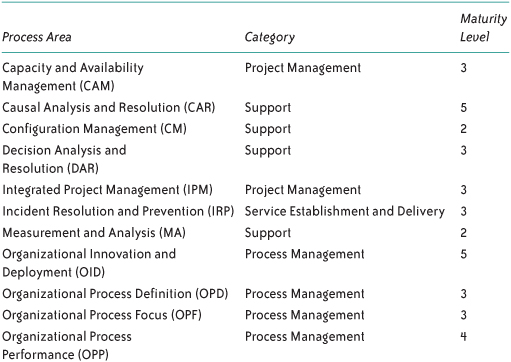

Equivalent Staging
Up to this point, we have not discussed process appraisals in much detail. The SCAMPI method1 is used to appraise organizations using CMMI, and one result of an appraisal is a rating [SEI 2006b, Ahern 2005]. If the continuous representation is used for an appraisal, the rating is called a “capability level.” If the staged representation is used for an appraisal, the rating is called a “maturity level” (e.g., maturity level 3).
1. The Standard CMMI Appraisal Method for Process Improvement (SCAMPI) method is described in Chapter 5.
Either type of rating can tell you a great deal about your organization’s process capability and maturity. However, capability level ratings are more difficult to use than maturity level ratings for the purpose of objectively comparing your organization with other organizations. How can you compare capability levels and maturity levels? Is such a comparison even possible?
Such a comparison is accomplished using a method called “equivalent staging,” which depends on an understanding of capability level profiles. A capability level profile is a list of process areas and the corresponding capability level achieved for each. This profile enables an organization to track its capability level by process area. The profile is called an “achievement profile” when it represents the organization’s actual progress for each process area. Alternatively, the profile is called a “target profile” when it represents the organization’s planned process improvement objectives.
Figure 4.2 illustrates a combined target and achievement profile. The green portion of each bar represents what has been achieved. The unshaded portion represents what remains to be accomplished to meet the target profile.
Figure 4.2 An Example of a Target and Achievement Profile
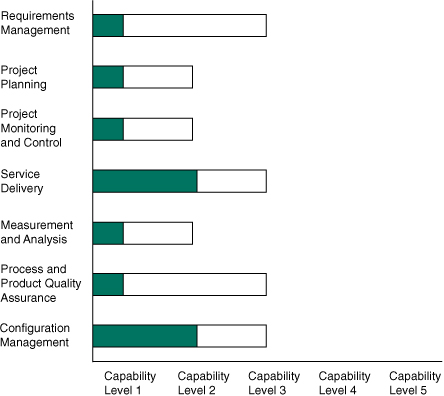
An achievement profile, when compared with a target profile, enables an organization to plan and track its progress for each selected process area. Maintaining capability level profiles is advisable when using the continuous representation.
Target staging is a sequence of target profiles that describes the path of process improvement for the organization to follow. When building target profiles, the organization should pay attention to the dependencies between generic practices and process areas. If a generic practice depends on a process area, either to enable the generic practice or to provide a prerequisite product, the generic practice may be much less effective when the process area is not implemented.2
2. See Table 7.1 (p. 220) in the Generic Goals and Generic Practices section of Part Two for more information about the dependencies between generic practices and process areas.
Although there are many reasons to use the continuous representation, ratings consisting of capability level profiles are limited in their ability to provide organizations with a way to generally compare themselves with other organizations. Capability level profiles could be used if each organization selected the same process areas; however, maturity levels have been used to compare organizations for years and already provide predefined sets of process areas.
Because of this situation, the CMMI Product Team created equivalent staging. Equivalent staging enables an organization using the continuous representation for an appraisal to convert a capability level profile to the associated maturity level rating.
The most effective way to depict equivalent staging is to provide a sequence of target profiles, each of which is equivalent to a maturity level rating of the staged representation. The result is a target staging that is equivalent to the maturity levels of the staged representation.
Figure 4.3 shows a summary of the target profiles that must be achieved when using the continuous representation to be equivalent to maturity levels 2 through 5. Each shaded area in the capability level columns represents a target profile that is equivalent to a maturity level.
Figure 4.3 Target Profiles and Equivalent Staging
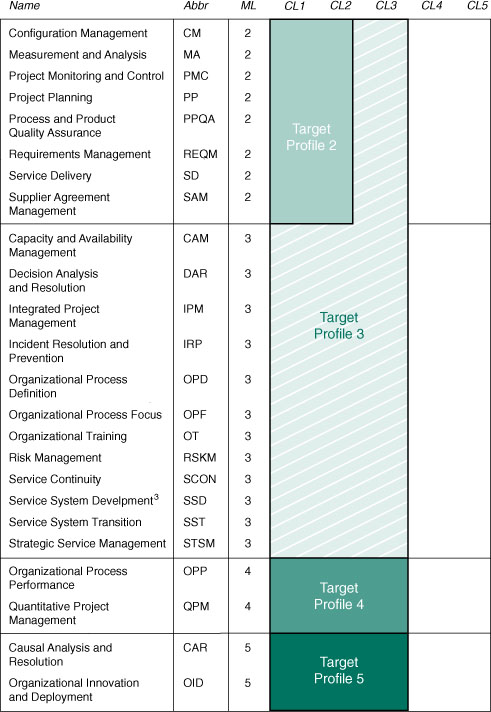
3. This process area is an “SSD Addition.”
The following rules summarize equivalent staging.
• To achieve maturity level 2, all process areas assigned to maturity level 2 must achieve capability level 2 or higher.
• To achieve maturity level 3, all process areas assigned to maturity levels 2 and 3 must achieve capability level 3 or higher.
• To achieve maturity level 4, all process areas assigned to maturity levels 2, 3, and 4 must achieve capability level 3 or higher.
• To achieve maturity level 5, all process areas must achieve capability level 3 or higher.
These rules and the table for equivalent staging are complete; however, you may ask why target profiles 4 and 5 do not extend into the CL4 and CL5 columns. The reason is that maturity level 4 process areas describe a selection of the subprocesses to be stabilized based, in part, on the quality and process-performance objectives of the organization and projects. Not every process area will be addressed in the selection, and CMMI does not presume in advance which process areas might be addressed in the selection.
So, the achievement of capability level 4 for process areas cannot be predetermined, because the choices depend on the selections made by the organization in its implementation of the maturity level 4 process areas. Thus, Figure 4.3 does not show target profile 4 extending into the CL4 column, although some process areas will have achieved capability level 4. The situation for maturity level 5 and target profile 5 is similar.
The existence of equivalent staging should not discourage users of the continuous representation from establishing target profiles that extend above capability level 3. Such a target profile would be determined in part by the selections the organization made to meet its business objectives.
